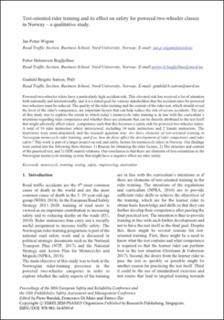| dc.contributor.author | Wigum, Jan Petter | |
| dc.contributor.author | Bogfjellmo, Petter Helmersen | |
| dc.contributor.author | Sætren, Gunhild Birgitte | |
| dc.date.accessioned | 2020-12-07T14:39:28Z | |
| dc.date.available | 2020-12-07T14:39:28Z | |
| dc.date.created | 2020-11-17T09:48:57Z | |
| dc.date.issued | 2020 | |
| dc.identifier.citation | Wigum, J. P., Bogfjellmo, P. H. & Sætren, G. B. (2020). Test-oriented rider training and its effect on safety for powered two-wheeler classes in Norway – a qualitative study. In: P. Baraldi, F. di Maio & E. Zio (Eds.), Proceedings of the 30th European Safety and Reliability Conference and the 15th Probabilistic Safety Assessment and Management Conference (ESREL-PSAM), Venice, Italy. | en_US |
| dc.identifier.isbn | 978-981-14-8593-0 | |
| dc.identifier.uri | https://hdl.handle.net/11250/2712251 | |
| dc.description.abstract | Powered two-wheeler riders have a particularly high accident risk. This elevated risk has received a lot of attention both nationally and internationally, and it is a stated goal for various stakeholders that the accident rates for powered two-wheelers must be reduced. The quality of the rider training and the content of the rider test, which should reveal the level of the rider's competence, are important factors that can help reduce the risk of severe accidents. The aim of this study was to explore the extent to which today’s motorcycle rider training is in line with the curriculum ́s intentions regarding rider competence and whether there are elements that can be directly attributed to the test itself that might adversely affect riders ́ competence such that this becomes a safety risk for powered two-wheeler riders. A total of 16 rider instructors where interviewed, including 14 male instructors and 2 female instructors. The interviews were semi-structured, and the research question was: Are there elements of test-oriented training in Norwegian motorcycle rider training, and if so, how do these affect the development of rider competence and rider safety? This work is part of a larger project on risk and safety factors for motorcycle riders in Norway. Our findings were sorted into the following three themes: 1) Reason for obtaining the rider license, 2) The structure and content of the practical test, and 3) GDE-matrix relations. Our conclusion is that there are elements of test-orientation in the Norwegian motorcycle training system that might have a negative effect on rider safety (PDF) Test-oriented rider training and its effect on safety for powered two-wheeler classes in Norway -a qualitative study. Available from: https://www.researchgate.net/publication/342643933_Test-oriented_rider_training_and_its_effect_on_safety_for_powered_two-wheeler_classes_in_Norway_-a_qualitative_study [accessed Nov 17 2020]. | en_US |
| dc.language.iso | eng | en_US |
| dc.publisher | Research Publishing | en_US |
| dc.relation.ispartof | e-proceedings of the 30th European Safety and Reliability Conference and 15th Probabilistic Safety Assessment and Management Conference (ESREL2020 PSAM15) | |
| dc.relation.ispartofseries | Proceedings of the 30th European Safety and Reliability Conference and the 15th Probabilistic Safety Assessment and Management Conference (ESREL-PSAM), 01 - 05 November 2020 Venice, Italy; | |
| dc.title | Test-oriented rider training and its effect on safety for powered two-wheeler classes in Norway – a qualitative study | en_US |
| dc.type | Chapter | en_US |
| dc.type | Peer reviewed | en_US |
| dc.description.version | publishedVersion | en_US |
| dc.subject.nsi | VDP::Samfunnsvitenskap: 200::Pedagogiske fag: 280 | en_US |
| dc.subject.nsi | VDP::Teknologi: 500 | en_US |
| dc.identifier.cristin | 1848649 | |
